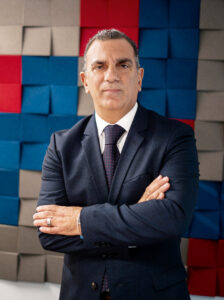Hybrid work policies can be a struggle for companies when people come into offices that still look like ghost towns. There’s a critical mass that’s needed to gain momentum and leaders play a critical role—they need to be accessible in ways they may not have considered in the past and to set the tone for the adoption of hybrid work.
 The current office might be a barrier to leaders who want to be accessible and role models for the new hybrid work. Workplace design traditionally focused on leaders’ needs by creating executive floors or suites that were set apart from the rest of the organization. It became a constraint to building transparency and made it harder for leaders to connect with employees. A fundamentally different approach to leadership spaces can be an important tool for building the kind of culture and fostering the kind of behaviors leaders want to see.
The current office might be a barrier to leaders who want to be accessible and role models for the new hybrid work. Workplace design traditionally focused on leaders’ needs by creating executive floors or suites that were set apart from the rest of the organization. It became a constraint to building transparency and made it harder for leaders to connect with employees. A fundamentally different approach to leadership spaces can be an important tool for building the kind of culture and fostering the kind of behaviors leaders want to see.
Organizations need to rebuild the social capital that was lost while everyone worked from home
One of the things that clearly emerged from various global studies is that employees want their leaders to be visible, accessible and transparent in how they run the business. For many leaders, this requires new behaviors and practices, which can be a challenge because they also need to get their jobs done.
So how can leaders balance the need to be more approachable to employees yet still have space to handle the moments of crisis they’re dealing with more frequently, as well as the day-to-day needs of the organization? How can they collaborate as a leadership team and share quickly with each other as well as the larger organization. And how do they do all this in a hybrid work environment when they need to interact both with people in-room and remote participants?
According to Sara Armbruster, CEO of Steelcase, workspaces can play an important role in shaping new leadership behaviors during this time of seismic change. Steelcase has a long history of prototyping and testing progressive new ways for leaders to work, and recently the company designed and implemented a new leadership space in their Learning and Innovation Center in Grand Rapids, Michigan, where research and insights will help create an innovative approach for leaders in a hybrid world.
Called the Leader Commons, Steelcase’s new leadership space is a fully built-out environment where concepts are tested and evaluated in real time. As its name implies, this space is designed to be highly accessible and approachable for employees, yet functional for the demands of leadership roles. It offers spaces where leaders and employees can focus and collaborate, both in person and remotely.
“We know organizations need to rebuild the social capital that was lost while everyone worked from home, “says Cherie Johnson, Steelcase’s global design director. “Traditional leadership spaces don’t offer the transparency and accessibility people want today.”
The design of the Leader Commons was inspired by dynamic neighborhoods that have a range of diverse public and private spaces which encourages equity, engagement and ease of use to address the needs of hybrid work.



